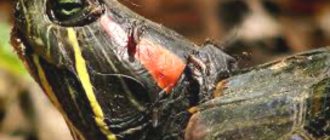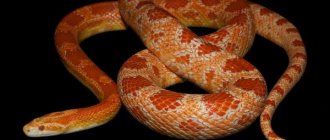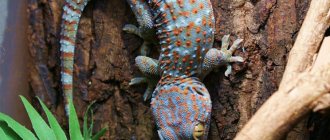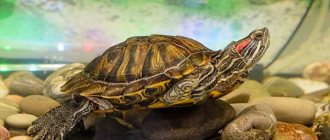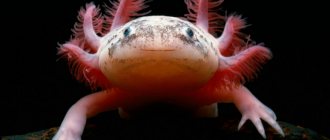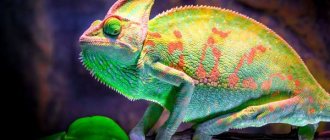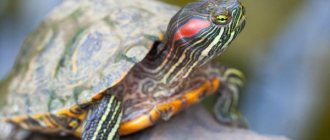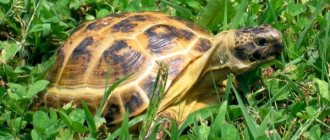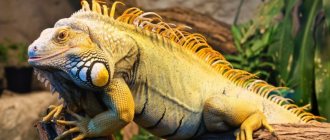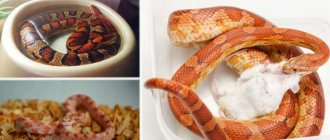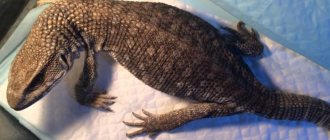The bearded dragon or bearded lizard (lat. Pogona vitticeps) is native to Australia, which is now quite accessible, as it is bred in captivity without problems. It is well suited for both beginners and experienced reptile lovers. Due to its flexibility, small size (40-50 cm), and ease of maintenance, it has become very popular in recent years. In this article you will learn how to care for, maintain and feed your bearded dragon.
Description
The bearded dragon (pogona vitticepes) is an Australian lizard with an unusual appearance. It belongs to the agamidae family, the squamate class. It owes its name to the leathery folds present on the beard, head and behind the ears. In nature, the reptile lives in desert rocky areas with depleted flora. Spends most of its life on the ground, but sometimes climbs trees. The lizard is active during the daytime, and at night it sleeps in some secluded place.
The bearded predator spends its entire life in its chosen territory and does not leave it for long distances. The regular diet consists of insects, small birds and rodents. The reptile may occasionally try something from the vegetation. Due to the small number of bodies of water in the territory it occupies, it draws moisture from the food it consumes. The reptile gets enough fluid during the rainy season.
Despite its threatening appearance, the lizard has a peaceful character. This trait was the reason for its domestication. However, during the mating season or during defense from an enemy attack, the animal’s behavior changes dramatically. The mood of a reptile can be determined by the color of its skin: the darker it is, the more restless it is.
The lizard is relatively small in size, no more than 60 cm long (including the tail). Her body is flattened, with a large, triangular-shaped head. There are spines on the neck that swell when there is danger, like a beard. The color of the back varies depending on the mood: green, yellowish, blue. The main tone is gray-brown, with a patterned pattern of randomly located spots and stripes.
The reptile's limbs are powerful, with thick and clawed fingers. There are spiny growths on the sides. The tail occupies about 30% of the total length. Domestic agamas rarely have long tails, as neighbors in the terrarium bite them off.
Lizards have a large mouth with many sharp teeth. The front row protrudes above the back row, as it is designed to capture the victim. Chewing occurs with the back teeth. At the tip of the long tongue there is Velcro, which helps the animal grab insects in flight. Excellent hearing and keen vision allow the agama to deftly navigate the hunt.
Nutrition
Like all lizards, the dwarf in the natural environment hunts insects, worms, and mollusks. She usually travels in search of prey, crawling on the ground or through trees. She moves jerkily and freezes for a while, waiting. Only after seeing potential prey does the predator make a lunge.
Usually it bites and tears prey with those teeth that are located in the front, and chews food with the back ones. It uses a sticky tongue to catch small insects. At the same time, tender young green shoots, flowers and fruits are an indispensable part of the lizard’s diet. It should be noted that this is a territorial creature. It hunts only in one specific area of land, which it tries not to leave.
Appearance
What is this lizard? She looks a little like a miniature crocodile. But not for a terrible predator, but for a cute one. The bearded dragon is large and muscular. Its body reaches a length of 60 cm, of which approximately 40% is the tail. The head is triangular in shape, the eyes are narrowed, dark in color. The upper part of the animal's body is covered with scales that look like sharp thorns. This makes the agama seem very formidable. In fact, there are no thorns. The scales are very soft and it is impossible to get hurt on them. In case of danger, the lizard inflates its subcervical crop. This allows it to visually increase in size and scares away potential enemies. As for the usual method of avoiding danger in the form of dropping the tail, this option is not for representatives of agamidae. Not because they are so brave, but due to the fact that their tail does not have the ability to recover.
Water
In order for agamas to drink, you can use a spray bottle. Just spray the walls of the terrarium, and they will already lick the drops from them and from the decor.
But don’t overdo it, it shouldn’t be too humid inside, after all, they live in dry deserts.
You can also put water in drinking bowls, most often they are styled like stones, but make sure that the water in them is clean.
Humidity is important for molting, since low molting is much more difficult. Sometimes you can practice bathing by lowering your agama into a container of warm water.
How long do bearded dragons live?
The lifespan of pets depends on their habitat, nutrition and proper lighting. It is a common myth that some pet bearded dragons can live up to 40 years, but this is not true. The maximum age mark differs depending on the subspecies of the pet:
- The lizard Pogona vitticeps lives in the zoo for 10 years, but in apartment conditions it often dies at the age of 6-7 years.
- The Swallowtail Agama Hydrosaurus can live 24-26 years in captivity if it is not overfed and kept in a large terrarium in which it can actively move.
Price
Today you can find private advertisements for the sale of young animals (from 2,000 rubles) and adults (20,000). In the second case, in addition to the lizard itself, you will be offered a room for keeping it, a lamp, soil and other accessories.
A terrarium for one reptile with a set of the minimum necessary set (the terrarium itself, flooring - for example, made of artificial grass, an ultraviolet lamp, a heating lamp, a turntable holder, a shelter for an agama, a thermometer) will cost a minimum price of 10 thousand rubles. But in pet stores the cost will be higher.
Choosing an agama
Before you buy an agama, make sure that the animal is healthy, because it is not cheap. Fortunately, there are several signs by which you can understand that she is not sick. Inspect for wounds and damage Examine your dragon carefully, looking for any scars or signs of injury, even if they have already healed. This may cause problems in the future, and if you have a choice, then take an animal without scars. Also inspect for fresh damage, wounds, or ulcers. Check the integrity of body parts Many lizards quickly regenerate lost body parts, but bearded dragons do not have this ability. If her tail or paw is torn off, then she will remain that way forever (no matter what the sellers tell you). However, if she is missing a finger or the tip of her tail, then this is a common occurrence and can be considered normal. Examine the head. There should be no foam or liquid around the mouth; the presence may be an indicator of disease. The eyes should be clear, the nostrils clean. Alertness Healthy agamas are always on the alert, because in nature they catch fast insects, and without attention they would die of hunger. An active and fast bearded dragon is the first sign of a healthy animal. True, they can be lethargic and lethargic, even when completely healthy, since they are not active 24 hours a day. Observe the selected lizard for a while. How she behaves, how she eats, how she moves.
Priming
For young agamas, it is best to use plain paper, napkins, toilet paper or special mats (substrates) for reptiles. They are very accessible, cheap, and safe for reptiles.
If you choose a substrate, the one that looks best is one that resembles grass. Do not use sand, gravel, or sawdust for juveniles and juveniles!
They are very clumsy eaters, very curious and can swallow such soil.
And this is already a health risk; sand and other small mixtures clog their intestines, which can lead to death.
Features of behavior
Despite their menacing appearance, the bearded dragon is easy to tame. However, it can bite and scratch, so be careful if the reptile changes color, snorts, hisses, crouches, wiggles its tail, or flares its neck.
Agamas with long tails are rarely found in terrariums. Individuals of the same sex often do not get along with each other and bite off each other’s tails, which then do not grow back. Australian lizards are fearless and do not hide from the enemy, preferring an active attack. In general, they are quite passive and just lie or sleep most of the time. Animals are usually more active during the day in sunlight.
Terrarium size
Young agamas can be kept in a terrarium of at least 100 liters and long enough. However, they grow quickly and will require more volume within a few months.
Adults must be kept in at least a 200-liter volume, and if the terrarium is even larger, it will only be better.
It is better to cover the terrarium with a lattice, since glass, plastic or wood will not allow air to circulate normally and moisture will accumulate in the terrarium.
The gratings will allow you to light and heat the terrarium without problems, and they also do not retain moisture.
For maintenance, you can use both aquariums made of glass and plastic, and terrariums designed specifically for reptiles. The main thing is that they do not have sharp edges or burrs.
Content
Keeping a bearded dragon is quite simple compared to other lizard species. The main criteria for keeping a healthy and happy lizard:
Spacious terrarium.
Bearded dragons reach adult size quite quickly, so I advise you to choose a terrarium immediately for an adult, namely a terrarium with a volume of at least 200 liters. When choosing a terrarium, also pay attention to good ventilation; it is better if instead of a glass or plastic lid there is a dense mesh or lattice.
This way you will ensure good air circulation in the terrarium, and your pet will feel good. This will also make it easier to heat the terrarium, light it and save you from the problem of excessively humid air in the terrarium, because the bearded dragon loves arid and very hot climates. A high-quality terrarium, as well as an aquarium, is suitable for keeping an agama. When choosing a home for your agama, make sure it is safe. Check that there is nothing inside that could accidentally harm the animal. And also, ensure the reliability of the terrarium. Even from a seemingly small hole, an agama can escape.
Good lighting.
By this point I mean not only the brightness of the light, but also the duration. For a healthy lifestyle, an agama needs 12-14 hours of daylight. At this point I would like to draw your attention to one feature of the light. There is not enough light from the window for lizards, even if the terrarium is placed directly under the direct rays of the sun. In the terrarium, it is necessary to artificially recreate the habitat familiar to this species. To do this, it is necessary to install a special UV lamp (a lamp with an ultraviolet spectrum of rays) in the terrarium, which will recreate the natural level of illumination, and most importantly, the level of necessary ultraviolet radiation.
Please note that there are different UV lamps. Bearded dragons require 7-8% UVB lamps. Ultraviolet light helps agamas synthesize vitamin D3, which is necessary for the full absorption of calcium. It is better to mount the lamps inside the terrarium, or place the lamps so that the rays pass through the grille, for minimal loss of ultraviolet radiation. When installing lamps inside the terrarium, especially when installing heating lamps in the terrarium, be sure to provide protection so that the lizard does not get burned by the hot lamp.
Temperature is especially important when keeping a bearded dragon.
In the summer there will be no special problems with keeping such a heat-loving animal, but during the rest of the year, most likely, you will have to constantly heat your pet. Favorable temperatures for keeping a bearded dragon healthy range from 30 to 40 degrees Celsius. But do not think that if for some reason the temperature drops slightly below 30C for some time, the agama will immediately die. Such fluctuations can seriously affect the animal's appetite and activity, but agamas are quite hardy animals. But you shouldn’t test the lizards’ endurance; try to stick to the recommended temperature range.
To maintain such a high temperature in the terrarium, there are several types of devices, for example, thermal heating mats, stones with a heating element, as well as heating lamps. All these devices have their pros and cons and are used for different types of animals. For agamas, a heating lamp is best suited, since, let me remind you that the bearded agama basically spends all of its time on the ground or on low shelters and pieces of wood, there is a chance that the agama will get burned if a thermal stone or thermo-stone is used. rug
Ideally, the terrarium should have a warming area and a cooler zone, in which case the agama will be able to regulate its own temperature. To control temperature and humidity, I recommend purchasing a special thermometer and hygrometer that has a sensor on a wire in order to be able to control the temperature and humidity directly in the terrarium.
Water and humidity.
Like any living creature, the bearded dragon needs free access to fresh water. Place a small drinking bowl in the terrarium and change the water there daily, and also spray the walls of the terrarium so that the agama drinks water, licking droplets of water from the walls and leaves. But keep an eye on the humidity in the terrarium. Favorable humidity in the terrarium for agama is 40%. Such humidity is important not only for the agama’s well-being, but also for favorable molting. If the humidity is insufficient, molting will be much more difficult or may even occur partially, which will cause serious harm to the animal.
The right soil.
When choosing a soil, pay attention not only to aesthetic properties, but also to safety. For young individuals, a regular napkin or grass-like substrate is suitable. Such precautions are associated with some clumsiness of young lizards, which can accidentally swallow pieces of soil. Unfortunately, the wrong choice of soil can lead to dire consequences. Do not use sand, sawdust, wood chips or gravel as substrate for young lizards.
Shelters.
It is important for any animal to have a place where they can feel safe. To do this, it is necessary to install comfortable shelters in the terrarium. When choosing a shelter, pay attention to the dimensions (the agama should easily enter there, be able to turn around there and, accordingly, calmly exit), as well as safety; shelters should not have sharp corners. You can buy a ready-made shelter at a pet store or make it yourself. Most likely, the dragon will spend more time hiding in a shelter, but this should not worry you. Lizards in captivity also spend more time in shelters, so this is normal behavior for a healthy animal.
Scenery.
When choosing decorations, pay attention to driftwood, branches, and stones. Agamas climb well. A stable branch or snag will perfectly decorate the terrarium and become a good place for the agama to rest, where she can warm up. When choosing driftwood, again, check it for safety. There should be no sharp branches on it, and it would also be better if you clear it of bark so that the agama does not accidentally swallow a piece. As the agama matures, it may be necessary to change the scenery; make sure that all shelters and decorations are suitable for the size of the lizard.
Lighting
For keeping bearded dragons, it is very important that the daylight hours be 12-14 hours.
The light falling into the terrarium from the window is completely insufficient for her, even if it is under direct rays.
To keep the lizard healthy, it is necessary to illuminate the terrarium with special ultraviolet lamps (UVB 7-8%) for at least 12 hours.
Since they live in the desert, they need the sun or its substitute for care and health. It is under ultraviolet rays that they can synthesize vitamin D3, which is necessary for the normal absorption of calcium. This means that you must recreate the spectral spectrum of sunlight.
Fortunately, this is now quite easy to do; any pet store will offer you a variety of lamps for reptiles. It is better to mount the lamps inside the terrarium so that the loss of rays is minimal.
How and what to feed your bearded dragon
With a high-quality and balanced diet, the life cycle of a lizard can increase significantly, it will acquire intense coloring and be more active. The owner of an exotic pet must take into account the following nuances:
- The bearded dragon is omnivorous - in its natural environment the reptile feeds on vegetation and insects;
- a reptile's diet is related to its age and size - the menu of young individuals should consist of 3/4 insects and 1/4 plants, but for adult lizards it is the opposite;
- When feeding, it is necessary to chop the food so that its pieces are no larger than the distance between the reptile’s eyes. You need to be especially careful when feeding your pet vegetables; large pieces can cause her to choke.
There are some peculiarities in feeding lizards of different ages.
Diet and feeding regimen of young animals
Juveniles grow very intensively, so they require food with high nutritional value, and plant products do not fully meet these requirements. According to reviews from the owners, young agamas do not eat plant food well, so you should not wait for the individuals to finish their meal - you can simply leave it until the evening and remove it at night.
It is recommended that young pets be given crickets three times a day. The serving size should be such that they eat it in a quarter of an hour. Residues of food must be removed from the tank.
Diet and feeding regimen of adult lizards
Individuals who have reached puberty do not require abundant protein food; the basis of their menu should consist of vegetable components. Although the process of lizards eating vegetables is not so interesting, this option is quite economical.
Reptiles do not know the measures and can overeat, which leads to their obesity and decreased activity. Since the individuals themselves cannot control this, this function falls on the shoulders of the owner. He must dose food and feed according to the established schedule.
Vegetables are given to reptiles three times a day, and one feeding should consist of insects. What insects are suitable for feeding these lizards? There are two main requirements for them - they must be non-toxic and nutritious. It is advisable to purchase them at specialized sales points, since creatures caught near your home may be carriers of parasites.
Reptiles enjoy feasting on:
- crickets;
- cockroaches (we are not talking about domestic Prussians);
- larvae of beetles (Khrushchak beetles);
- zoophobus larvae;
- earthworms and crawlings.
Vegetables, fruits, and plants should also be healthy; they act as sources of vitamins and minerals. The following can be given to reptiles:
- cabbage;
- dandelions;
- carrot tops;
- parsley;
- alfalfa;
- hibiscus;
- strawberries;
- pieces of apples, melon.
All products are given raw, without preliminary heat treatment, they should be cut into small pieces.
Decor
Agamas love to climb somewhere and bask in the sun, so it is better to add things to the terrarium that even the heaviest and largest can climb on.
It can be:
branches and snags are excellent climbers, so a good branch or two will not only greatly decorate the terrarium, but will also make her feel comfortable.
Choosing them is not difficult, the main thing is that there is no bark on it (pieces of which agamas can swallow) and no insects. By the way, an old aquarist trick - soaking - will help get rid of the bark.
Immerse the driftwood in water and part of the bark will peel off on its own.
Islets
Platforms that are placed under heating lamps. These can be either artificial things or large stones. The latter is best, for example dark rocks, they absorb heat and allow you to warm up more evenly.
For me, as a novice terrariumist, it was a big surprise that sexually mature females can lay “empty clutches.” This happens in the spring, when agamas breed. The female begins to dig, dig a lot. There may or may not be eggs, it all depends on physiology. Also, during this period there may be problems with appetite. All these factors scared me and I ran to a herpetologist, to which he replied that everything was fine with the agama, it just “happens like this.”
Ivan Yevtushenko
Breeding
We found out everything about agamas: how to keep them, how to care for them, feed them, water them, and even what size a bearded dragon is as an adult. But there is one more subsection worthy of our attention. This is breeding of these lizards. It is better to start breeding exotic comrades when they are two years old. First, they are given winter quarters. In December, the male and female are separated, and the temperature in the new homes of both individuals begins to slowly decrease. Its daytime norm is from 23 to 26 degrees, and its nighttime norm is from 16 to 21 degrees. This reduction occurs within 10-14 days. Daylight hours are reduced to 9 hours. Pets become less active and eat less.
This regime is maintained for 10-12 weeks. Then the temperature is gradually increased and the future parents are fed generously with food supplemented with calcium. The male is placed next to the female, and the active courtship phase continues for 14-21 days. The groom fluffs out his beard, actively nods his head, and changes color. After this period, mating occurs.
The first signs of pregnancy in a female appear within a month. She's bloated with balls. The expectant mother walks around the terrarium, intensively digging and scratching something. Shortly before laying eggs, the lizard refuses to eat. 50-90 days after this, the young hatch. Young animals must have constant access to water, and the diet is detailed above. The babies are fed 3-4 times a day. After they are born, the parents are removed.
Heating the terrarium
Again, bearded dragons come from the desert, which means they require high temperatures. The temperature in the terrarium should be no lower than 30°C and no higher than 40°C. Do not use stones with a heating element inside for this, as they may cause burns.
The easiest way is to use regular incandescent lamps, but better are special lamps for heating a terrarium, which are again sold in pet stores.
If you have a fairly spacious terrarium, then we can create a cool and hot zone. A lamp will be located in the heating zone and the agama will warm up in it, and cool down in the cool zone as needed.
The temperature and humidity inside must be checked constantly so that they do not exceed the norm.
A thermometer and a hygrometer are quite cheap and it is better to put two thermometers (in the cool and hot zones) and one hygrometer.
Combination thermometers and hygrometers for reptiles, collected in one device, are now popular.
Bearded Dragon Diseases and Treatments
The most common diseases seen in captive bearded dragons are:
- Pneumonia - may appear due to low temperature or drafts in the terrarium. A sign is that the lizard has a runny nose; it begins to breathe through its mouth. Treatment is carried out with the antibiotic Ampicillin for 7 days if the reptile has mucus in the mouth, and 9–15 days if the disease is characterized by wheezing. The interval between drug administration is 72 hours.
- Ticks can develop if there is excess food left behind. In this case, the terrarium must be disinfected.
- Calcium deficiency is very common in dragons. In this case, the gait becomes unsteady, the lizard’s paws hurt, and swelling may appear. As therapy, you need to give the reptile a calcium complex with the addition of vitamins A, B and D3 for a week. If you have any symptoms of calcium deficiency - loss of appetite, decreased mobility, bone deformation, swelling in the larynx - you should immediately contact a veterinarian-herpetologist.
- Tissue necrosis. Due to poor diet, infection, or a general decrease in immunity, part of the reptile's tail may dry out and fall off. But this only poses a danger to young animals.
- Salmonellosis is a bacterial infection of the intestines that can cause the death of a lizard. Symptoms include refusal to eat, diarrhea, regurgitation, and weight loss. Treatment is carried out with the antibiotic Chloramphenicol, which is injected into the stomach through a tube 2-3 times. The drug Bactrim is also administered for 7 days.
- Cloacitis is an inflammation of the cloaca. It is characterized by purulent discharge during bowel movements, after which defecation is disrupted. For treatment, the drug Tetravil is dissolved in warm water and injected into the agama’s intestines using a catheter. The volume of liquid depends on the weight of the reptile.
- Stomatitis is an inflammation of the oral mucosa. Occurs as a result of a deficiency of vitamins A and C or mechanical damage. The disease is indicated by a pale bluish tint of the oral cavity with visible vessels. In this case, the agama’s mouth is treated with a 1% solution of the drugs Dioxidin, Iodinol or Ectericide. The affected areas are lubricated with Neosporin or Polysporin ointment twice a day for a week. Vitamin C is also administered.
- Intestinal blockage - can occur due to ingestion of bedding particles and cause the death of the lizard. In this case, surgery is required.
Refusal to eat is the first sign of most diseases, but overfeeding is often the cause. If the dragon does not eat for 2 days, but drinks water in normal quantities, this is normal. On the third day, you need to force-feed, take a warm bath and take a closer look at other symptoms.
Shelters
Your lizard needs a place to hide. There she could feel safe and rest in the shade. You can buy special shelters at the pet store that resemble natural stones, or you can make your own.
The main thing is that it is spacious enough and you can turn around in it.
Some owners become concerned if their dragon hides for too long and remove the hiding place during the day. However, it is better to leave it alone and not touch the shelter; the lizard itself will figure out when to hide and when to be active.
Reptile colors
Most often, individuals are found with a grayish or brownish color, but there are agamas of other variations - red, orange shades, as well as white individuals. Common representatives of bearded dragon subpopulations are the following species:
- German giant;
- Italian Leatherback Morphs (leatherback);
- Salmon;
- Sandfire;
- Snow;
- Blood Red;
- Leucistic;
- Silk morph;
- Translucent Morph;
And there are also: - Sunbeam;
- Japanese Dragon Silverback;
- Leatherback;
- Dragon "Dunner".
As for color options, there are white, yellow, red, black, orange morphs, bearded dragons with a tiger pattern.
